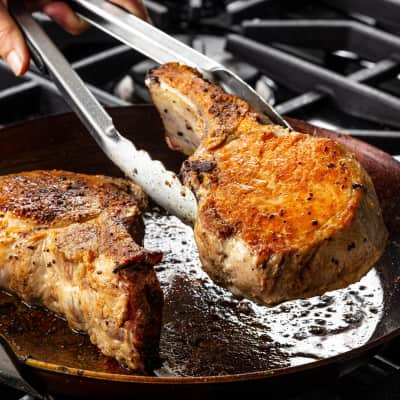In 2020, my former colleague Andrew Janjigian developed a recipe that was nothing short of game-changing: splatterless, smokeless, perfectly pan-seared steaks. Unlike the reverse-sear method, his technique doesn’t even require an oven: just a dry pan on the stovetop, in which the steaks are flipped frequently during cooking. In minutes, you end up with beautifully browned steaks with rosy interiors and no mess to boot. This “cold-sear” method, as we’ve come to call it at Cook’s Illustrated, is so simple yet foolproof that I was eager to apply it to other cuts of meat, and I wondered if it might be particularly beneficial for leaner cuts that are prone to drying out during a traditional sear. Enter: pork chops. Through the cold-sear method, I hoped to achieve chops with even, flavorful browning and juicy, tender interiors, a company-worthy dish that I could enjoy with guests without having to fuss over the mess it left behind on my stovetop.
Cold-Sear Your Pork Chops
Published Nov. 30, 2021.

How to Cold-Sear
1. Cook in a Dry Nonstick or Carbon-Steel Pan
Minimizing the amount of fat in the pan reduces smoke and splatter. A smooth surface prevents the chops from sticking without oil and allows more savory browning to stick to the meat, not the pan.
2. Don’t Preheat
Adding the chops to a cold pan allows their interiors to heat up gradually and evenly.
3. Start Hot; Then Back Off
The first burst of high heat drives off moisture so that the meat sears; lowering the temperature staves off smoke and helps the interior and exterior finish cooking at the same time.
4. Flip Frequently
Flipping the chops every 2 minutes cooks them from the bottom up and the top down so that their interiors warm evenly and their crusts build up gradually. It also leads to faster cooking.
A Cut Above the Rest
For this recipe, I quickly settled on bone-in rib chops, which are a tender and flavorful cut that features one large eye of loin muscle surrounded by fat. The bone helps insulate the meat, keeping it juicier (and it contains superflavorful bits to gnaw on). I opted for thicker, 1½-inch chops, which would both make for a more impressive presentation and cook through more slowly than standard 1-inch chops, allowing for more time to build up a browned crust using the cold-sear method. The added heft from the extra-thick chops also helped avoid buckling, or the tightening of the chops’ outer band of connective tissue, which can cause the chops to curl and sear unevenly.

shopping: Rib Chops
Bone-in rib chops may be labeled as rib cut, end cut, or center cut. To be sure that you are purchasing the correct chop, look for ones that feature one large eye of loin muscle. Be sure to seek out 1½-inch-thick chops for this recipe; the extra weight allows for longer cooking and better browning.
All About the Flip
The cold sear begins with a dry, nonpreheated 12-inch nonstick (or carbon-steel) skillet. Starting the chops in a cold pan allows them to heat up gradually and evenly, which prevents the meat directly below the surface from overcooking. Using nonstick allowed me to skip adding oil to the pan, which greatly reduces splatter and smoke, and the cold start avoids the safety hazard of overheating nonstick cookware. I placed two large chops (which would be plenty to serve four once sliced) in the skillet, maximizing space by arranging them so that the wider end of one chop was next to the narrower end of the other, and then set the pan over a burner set to high heat. I cooked the chops for 2 minutes on each side, at which point no real browning had taken place, and then adjusted the heat to medium (which kept the skillet hot enough to continue browning but not so hot that the fat smoked) and continued to flip the chops every 2 minutes until they were deeply browned and reached an internal temperature of 140 degrees. Regular flipping is the key to the technique: It evenly heats both sides of the chop at (almost) the same time, cooking the chop faster and more evenly than a traditional uninterrupted sear. And, as long as the pan is hot enough, the protein will still develop a rich, mahogany crust—it just happens gradually, like multiple coats of paint applied to a wall.
Temping Bone-In Pork Chops

When taking the temperature of your chop, use tongs to lift the meat from the pan and then insert the thermometer sideways into the center of the chop, avoiding the bone.
Going Whole Hog
I let the chops rest for 5 minutes after cooking and then carved them off the bone, slicing the meat ½ inch thick. The chops’ browned crusts and tender, juicy interiors make for an impressive main course when served with just a sprinkle of sea salt, but I also wanted to develop a couple sauces to dress them up even more for entertaining. Using flavors that naturally pair with pork, I devised two options: a sweet, spicy, and creamy apple-mustard sauce and a glossy maple agrodolce. Intensely flavored, viscous enough to cling to the meat, and quick to make, either makes for a dazzling finishing touch.

COLD-SEARING on an electric stovetop
Electric stoves can be slow to respond to a cook’s commands. This can pose a problem with our cold-searing method, which requires an initial blast of high heat followed by a quick turndown to medium heat. However, there’s a simple work-around: As you cook your chops on high heat on one burner, preheat a second burner to medium heat. After the initial sear, transfer the pan to the medium-heat burner and continue cooking.


